
Plesiosaurus is a genus of extinct, large marine sauropterygian reptile that lived during the Early Jurassic. It is known by nearly complete skeletons from the Lias of England. It is distinguishable by its small head, long and slender neck, broad turtle-like body, a short tail, and two pairs of large, elongated paddles. It lends its name to the order Plesiosauria, of which it is an early, but fairly typical member. It contains only one species, the type, Plesiosaurus dolichodeirus. Other species once assigned to this genus, including P. brachypterygius, P. guilielmiimperatoris, and P. tournemirensis have been reassigned to new genera, such as Hydrorion, Seeleyosaurus and Occitanosaurus.
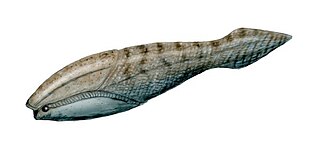
Arandaspida is a taxon of very early, jawless prehistoric fish which lived during the Ordovician period. Arandaspids represent the oldest known craniates, a proposed group of chordates that contain all chordates with a cartilage-derived skull, and hagfish. The group represents a subclass within the class Pteraspidomorphi, and contains only one order, the Arandaspidiformes. The oldest known genus of this group is Sacabambaspis found in South America.
This glossary of ichthyology is a list of definitions of terms and concepts used in ichthyology, the study of fishes.
Calyptosuchus is an extinct genus of aetosaur from the Late Triassic of North America. Like other aetosaurs, it was heavily armored and had a pig-like snout used to uproot plants.

The Bursidae, common name "frog snails" or "frog shells", are a rather small taxonomic family of large sea snails, marine gastropod predatory snails in the clade Littorinimorpha.

Dissorophus (DI-soh-ROH-fus) is an extinct genus of temnospondyl amphibian that lived during the Early Permian Period about 273 million years ago. Its fossils have been found in Texas and in Oklahoma in North America. Its heavy armor and robust build indicate Dissorophus was active on land, similar to other members of the clade Dissorophidae that are known from the Late Carboniferous to the Early Permian periods. Dissorphus is distinguished by its small body size, disproportionately large head and short trunk.

Brachycephalus alipioi is a species of frogs in the family Brachycephalidae, genus Brachycephalus. It is endemic to the Atlantic rainforest of the Espírito Santo state of southeastern Brazil. They can be found walking slowly on the leaf litter or on the forest floor. Mites and spiders were found in the stomachs of two of the specimen, although their diet may be more abundant. All specimens were diurnal.
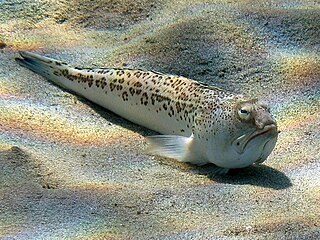
The starry weever, or streaked weever, Trachinus radiatus, is a fish of the family Trachinidae widespread in the eastern Atlantic from Gibraltar to the Gulf of Guinea, and probably further south; it is also known from the Mediterranean Sea. A marine subtropical fish, it grows up to 50 cm (20 in) in length.
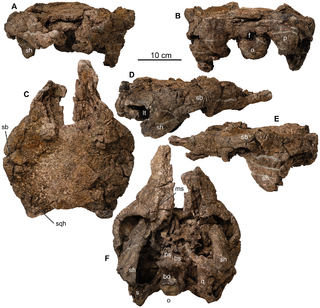
Europelta is a monospecific genus of nodosaurid dinosaur from Spain that lived during the Early Cretaceous in what is now the lower Escucha Formation of the Teruel Province. The type and only species, Europelta carbonensis, is known from two associated partial skeletons, and represents the most complete ankylosaur known from Europe. Europelta was named in 2013 by James I. Kirkland and colleagues. Europelta has an estimated length of 5 metres and weight of 1.3 tonnes, making it the largest member of the clade Struthiosaurini.
Microbrachius is an extinct genus of tiny, advanced antiarch placoderms closely related to the bothriolepids. Complete articulated specimens show that the armored section of the body had an average length of 2-4 cm. Species of Microbrachius are characterized by having large heads with short thoracic armor. Specimens of Microbrachius have been found in Scotland, Belarus, Estonia, and China. Specimens range in age from the Lower Devonian Late Emsian Stage to the Middle Devonian Upper Givetian Stage.

Amphiaspididae is a family of extinct amphiaspidid heterostracan agnathans whose fossils are restricted to Lower Devonian marine strata of Siberia near the Taimyr Peninsula. In life, the amphiaspidids of Amphiaspididae are thought to be benthic animals that lived most of their lives mostly buried in the sediment of a series of hypersaline lagoons. Amphiaspids are easily distinguished from other heterostracans in that all of the plates of the cephalothorax armor are fused into a single, muff-like unit, so that the forebody of the living animal would have looked like a potpie with a pair of small, or degenerated eyes, with each flanked by a preorbital opening, and a simple, slit-like mouth.

Amphoraspis stellata is an amphiaspidid heterostracan in the family Amphiaspididae. Its fossils are restricted to early Devonian-aged marine strata of the Taimyr Peninsula, Siberia. A. stellata, as with all other amphiaspidids, is thought to have been a benthic filter feeder that lived on top of, or buried just below the surface of the substrate of hypersaline lagoon-bottoms.
Edaphaspis bystrowi is an extinct amphiaspidid cyathaspidid heterostracan. Its fossils are restricted to early Devonian-aged marine strata of the Taimyr Peninsula, Early Devonian Siberia. E. bystrowi, as with all other amphiaspidids, is thought to have been a benthic filter feeder that lived on top of, or buried just below the surface of the substrate of hypersaline lagoon-bottoms. It is the only representative of the family Edaphaspididae.
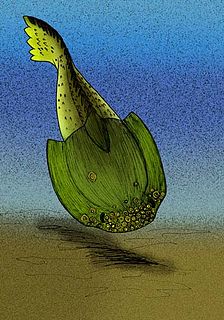
Gabreyaspididae is a family of extinct amphiaspidid heterostracan agnathans whose fossils are restricted to Lower Devonian marine strata of Siberia near the Taimyr Peninsula. In life, all amphiaspidids are thought to be benthic animals that lived most of their lives mostly buried in the sediment of a series of hypersaline lagoons. Amphiaspids are easily distinguished from other heterostracans in that all of the plates of the cephalothoracic armor are fused into a single, muff-like unit, so that the forebody of the living animal would have looked, in the case of gabreyaspidids, vaguely like a horseshoe crab with a pair of small, or degenerated eyes, with each flanked by a preorbital opening, and a simple, slit-like mouth positioned slightly ventrally.
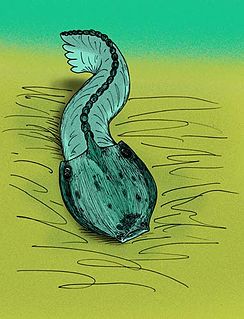
Olbiaspididae is a family of extinct amphiaspidid heterostracan agnathans whose fossils are restricted to Lower Devonian marine strata of Siberia near the Taimyr Peninsula. In life, all amphiaspidids are thought to be benthic animals that lived most of their lives mostly buried in the sediment of a series of hypersaline lagoons. Amphiaspids are easily distinguished from other heterostracans in that all of the plates of the cephalothoracic armor are fused into a single, muff-like unit, so that the forebody of the living animal would have looked, in the case of olbiaspidids, vaguely like a hot water bottle with a pair of small, or degenerated eyes, with each flanked by a preorbital opening, and a simple, slit-like mouth positioned at the anteriormost portion of the cephalothoracic armor.
Eglonaspididae is a family of extinct amphiaspidid heterostracan agnathans whose fossils are restricted to Lower Devonian marine strata of Siberia near the Taimyr Peninsula. In life, all of the amphiaspidids are thought to be benthic animals that lived most of their lives mostly buried in the sediment of a series of hypersaline lagoons. Amphiaspids are easily distinguished from other heterostracans in that all of the plates of the cephalothoracic armor are fused into a single, muff-like unit, so that the forebody of the living animal would have looked, in the case of elgonaspidids, very much like a hot water bottle with or without a pair of small, degenerated eyes and a simple, slit-like mouth positioned at the anteriormost portion of the cephalothoracic armor.

Asterolepis is an extinct genus of antiarch placoderms from the Devonian of North and South America and Europe. They were heavily armored flat-headed benthic detritivores with distinctive jointed limb-like pectoral fins and hollow spine. The armor plate gives the Asterolepis a box-like shape. Its pectoral fins are also armored but the caudal and dorsal fin are not. The first fossils were named by M. Eichwald in 1840 after noticing star-like markings on the fossils.

Stegouros is a genus of ankylosaurian dinosaur from the Late Cretaceous Dorotea Formation of southern Chile. The genus contains a single species, Stegouros elengassen, known from a semi-articulated, near-complete skeleton.

Kimbryanodus is a genus of extinct ptyctodontid placoderm fish from the Frasnian of Australia.These placoderms can be told apart from others due to the large eyes, crushing tooth plates, long bodies, reduced armor, and a superficial resemblance to holocephalid fish. The group is so far the only Placoderms known with sexually dimorphic features. The fossils occur as small three dimensional isolated plates. Because of these new specimens the Ptyctodontid grouping got a taxonomic classification, it found that the genus Rhamphodopsis to be the most basal taxa. They are divided by having the more basal taxa having a median dorsal spine, a simple spinal plate, and a simple V-shaped overlap of the anterior lateral and the anterior dorsolateral plates.

Scirrotherium is an extinct genus of pampatheres, a family of herbivorous cingulates, related to the similar but smaller modern armadillos, and with the now extinct glyptodonts, well-known from their shell-like armor. Its scientific name is derived from the Greek prefix "skiros-", "cover", and the suffix "-therion, "beast", while the name of the type species, hondaensis, honors the town of Honda, in the Tolima Department of Colombia. Scirrotherium is one of several genera of xenarthrans found in the La Venta fauna, dated from the Middle Miocene.















